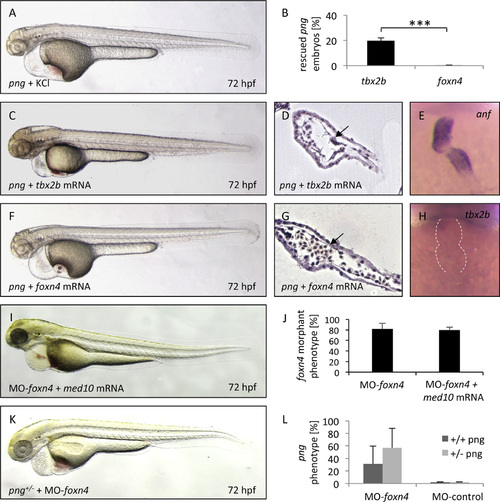Fig. 3
- ID
- ZDB-FIG-160830-3
- Publication
- Just et al., 2016 - The mediator complex subunit Med10 regulates heart valve formation in zebrafish by controlling Tbx2b-mediated Has2 expression and cardiac jelly formation
- Other Figures
- All Figure Page
- Back to All Figure Page
|
Ectopic expression of Tbx2b rescues the valve defect in png mutants. (A-E) Injection of tbx2b RNA into homozygous png mutants leads to the reconstitution of endocardial cushion development (19.70% ± 2.32%, n = 101, P < 0.001, 4 independent experiments) (B-D), whereas injection of KCl has no effect (A). (D) H&E staining of sections of a tbx2b RNA-injected png heart at 72 hpf. Endocardial cushion development (black arrow) in png hearts is reconstituted. (E) In tbx2b RNA-injected png hearts, anf is only present in the ventricular and atrial myocardium and not in the AVC. (B, F-H) Injection of foxn4-RNA into homozygous png mutants does not rescue endocardial cushion development (n = 87, 3 independent experiments). (G) H&E staining of sections of a foxn4 RNA-injected png heart at 72 hpf. No endocardial cushions are formed in foxn4 RNA-injected png hearts. (H) Tbx2b expression is not reconstituted in AV myocardial cells in png mutants injected with foxn4-RNA. (I, J) Injection of MO-foxn4 leads to a heart valve phenotype in 81.80% ± 10.33% (n = 122, 4 independent experiments) and co-injection of med10-RNA and MO-foxn4 does not rescue the foxn4 morphant phenotype (80.01% ± 5.36, n = 198, 4 independent experiments). (K, L) Injection of MO-foxn4 in wt (31.31% ± 28.61%, n = 54, 4 independent experiments) and heterozygous png embryos (56.79% ± 31.36%, n = 97, 4 independent experiments) revealed a sensitizing effect of Foxn4-depletion on heterozygous png embryos. |
| Fish: | |
|---|---|
| Knockdown Reagent: | |
| Observed In: | |
| Stage: | Protruding-mouth |

